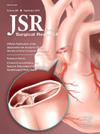Outcomes After ERAS Pathway in Open and Robotic Pancreatic Surgery: A Retrospective Cohort Study
IF 1.7
3区 医学
Q2 SURGERY
引用次数: 0
Abstract
Introduction
Enhanced recovery after surgery (ERAS) pathways improve outcomes for patients following open pancreaticoduodenectomy (PD). However, the impact of ERAS protocols following robotic pancreas surgery is less understood. This study aims to compare patient outcomes in open and robotic pancreas surgery, including PD and distal pancreatectomy (DP), following implementation of an ERAS pathway.
Methods
This single-center retrospective cohort study was conducted from August 2018 to December 2022 and analyzed patients who underwent pancreatic surgery. Baseline characteristics, perioperative and postoperative outcomes, including postoperative morphine utilization, were compared between ERAS and non-ERAS cohorts. Univariate and multivariable analyses were performed.
Results
Of the 220 patients included in the study, average age was 68 y, 50.5% were female, 64.5% underwent PD, and a robotic approach was utilized in 68.6% of patients. The ERAS cohort required less postoperative opioids (58 versus 148 morphine milligram equivalents, P < 0.0001), and had lower pain scores on postoperative day 0 (6 versus 8, P < 0.0001) compared to the non-ERAS cohort. On multivariable analyses, the ERAS cohort was less likely to experience a complication overall (P < 0.0001), and in the PD (P = 0.0004), DP (P = 0.0003), and robotic subgroups (P = 0.0002).
Conclusions
The utilization of an ERAS pathway following pancreatic surgery is associated with reduced postoperative opioid use, lower pain scores, and fewer complications, supporting its safety and feasibility for PD, DP, and use in a robotic approach.
开放和机器人胰腺手术ERAS通路后的结果:一项回顾性队列研究
手术后增强恢复(ERAS)途径改善了开腹胰十二指肠切除术(PD)患者的预后。然而,机器人胰腺手术后ERAS方案的影响尚不清楚。本研究的目的是比较开放胰腺手术和机器人胰腺手术的患者结果,包括PD和远端胰腺切除术(DP),在实施ERAS途径后。方法本研究于2018年8月至2022年12月进行单中心回顾性队列研究,分析接受胰腺手术的患者。比较ERAS组和非ERAS组的基线特征、围手术期和术后结局,包括术后吗啡使用情况。进行单变量和多变量分析。结果在纳入研究的220例患者中,平均年龄为68岁,50.5%为女性,64.5%的患者接受了PD治疗,68.6%的患者采用了机器人方法。ERAS组术后所需阿片类药物较少(58毫克吗啡对148毫克吗啡当量,P <;0.0001),术后第0天疼痛评分较低(6比8,P <;0.0001)与非eras队列相比。在多变量分析中,ERAS队列总体上不太可能出现并发症(P <;0.0001), PD (P = 0.0004), DP (P = 0.0003)和机器人亚组(P = 0.0002)。结论胰腺手术后ERAS通路的使用可减少术后阿片类药物的使用,降低疼痛评分,减少并发症,支持其用于PD, DP和机器人入路的安全性和可行性。
本文章由计算机程序翻译,如有差异,请以英文原文为准。
求助全文
约1分钟内获得全文
求助全文
来源期刊
CiteScore
3.90
自引率
4.50%
发文量
627
审稿时长
138 days
期刊介绍:
The Journal of Surgical Research: Clinical and Laboratory Investigation publishes original articles concerned with clinical and laboratory investigations relevant to surgical practice and teaching. The journal emphasizes reports of clinical investigations or fundamental research bearing directly on surgical management that will be of general interest to a broad range of surgeons and surgical researchers. The articles presented need not have been the products of surgeons or of surgical laboratories.
The Journal of Surgical Research also features review articles and special articles relating to educational, research, or social issues of interest to the academic surgical community.

 求助内容:
求助内容: 应助结果提醒方式:
应助结果提醒方式:


